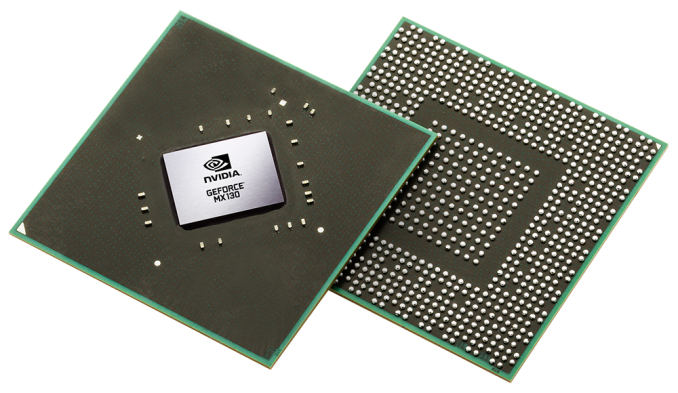NVIDIA Releases Maxwell-based GeForce MX130 & MX110 Mobile GPUs
by Nate Oh on November 28, 2017 8:55 AM EST
Earlier this month, NVIDIA quietly released the Maxwell-based entry-level GeForce MX130 and MX110, joining the earlier Pascal-based MX150. The MX130 and MX110 product pages were later updated to specify that they were Maxwell-based parts. These discrete mobile GPUs are OEM-focused, and fill out the very bottom of NVIDIA’s mobile GPU product stack.
Officially, as with previous low-end GPU launches, NVIDIA is remaining tight-lipped on formal GPU specifications. In lieu of hard numbers on CUDA cores and clocks – the latter of which is variable among laptop designs due to power and cooling – NVIDIA is citing performance relative to the Intel UHD 620, the iGPU featured in the i5-7200U (and most other Intel 8th Gen Core CPUs). There the company has the MX110 listed as 1.5x faster in games than the UHD 620, while the MX130 is cited as 2.5x faster. In comparison, the MX150 was cited at 4x faster than the Intel's iGPU.
| Best Guess: NVIDIA Laptop Video Card Specification Comparison | |||||
| MX150 | MX130 | MX110 | |||
| CUDA Cores | 384 | 384 | 256 | ||
| ROPs | 16 | 8 | 8 | ||
| Boost Clock | Variable | Variable | Variable | ||
| Memory Type | GDDR5 | GDDR5/DDR3 | GDDR5/DDR3 | ||
| Memory Bus Width | 64-bit | 64-bit | 64-bit | ||
| VRAM | <=2GB | <=2GB | <=2GB | ||
| GPU | GP108 | GM108 | GM108 | ||
| Manufacturing Process | Samsung 14nm | TSMC 28nm | TSMC 28nm | ||
| Launch Date | 05/26/2017 | 11/2017 | 11/2017 | ||
Presumably, these parts are GM108-based 940MX and 920MX rebrands, a common occurrence in mobile GPUs. A SiSoftware entry for a Dell Latitude 5591, mentioned on a Dell Accessories product page, details the MX130 as a 384 CUDA core configuration at 1189 MHz, which again suggests a rebranded GeForce 940MX. Based on the performance difference between the MX130 and MX110, it is likely that the MX110 is a rebrand of the 256 CUDA core 920MX, as opposed to the 384 CUDA core 930MX. As the MX130 and MX110 features both DDR3 and GDDR5 interfaces, OEMs may outfit video memory as they see fit.
Both Maxwell parts support Optimus and Turbo Boost 2.0. As is typical with their low-end mobile product launches, NVIDIA had no further details or information to provide.
Source: NVIDIA (via SH SOTN)










27 Comments
View All Comments
Ro_Ja - Tuesday, November 28, 2017 - link
TL;DRMX110 is a rebranded 920MX and the MX130 is a rebranded 940MX
peevee - Wednesday, November 29, 2017 - link
Exactly. And mister Nate Oh decided to put this information only at the very end of the article, wasting everybody's time. Not cool.Nate Oh - Thursday, November 30, 2017 - link
Neither of them were confirmed as exact rebrands of the 920MX and 940MX, and we are not in the business of publishing rumors and stating unconfirmed single-sourced reports as facts. The GPUs being confirmed as "Maxwell-based" and specifications in the Best Guess table should tell you all you need to know, and for a ~280 word article, I think it's rather unlikely I wasted more than 30 seconds of anyone's time :)Phylyp - Tuesday, November 28, 2017 - link
Why do they tarnish the good name of the MX150 by releasing similarly named GPUs build on older Maxwell technology. Sigh. I'd be happier to see an option of something above the MX150 instead.tipoo - Tuesday, November 28, 2017 - link
Yeah, that's particularly silly, the MX150 was racking up a lot of good joojoo.ImSpartacus - Tuesday, November 28, 2017 - link
These cheap OEM-friendly parts will have their name tarnished eventually, so Nvidia probably dgaf.The OEMs have too much control. They will inevitably gimp it to abuse the goodwill that "discrete" graphics have earned.
tipoo - Tuesday, November 28, 2017 - link
>Maxwell>nearly 2018
butwhy.gif. They're low performance parts, but what disadvantage would there be for them to be Pascal?
bug77 - Tuesday, November 28, 2017 - link
Not to mention they're 28nm parts that will suck your battery dry compared to newer parts.PeachNCream - Tuesday, November 28, 2017 - link
There's nothing that says technological advancement like releasing a rebranded 28nm GPU in 2017! </sarcasm>DanNeely - Tuesday, November 28, 2017 - link
Cost. The bottom of the market is extremely price sensitive; if GP108 yields are good enough that there aren't enough partially flawed parts available to fit the next step down in performance something made on a legacy process will be cheaper (cost/transistor stopped falling a process or two ago).If you look at previous generations the bottom of the market GPUs have often been 1 or even 2 generation old designs for this reason. It's nothing new for either Nvidia or AMD.